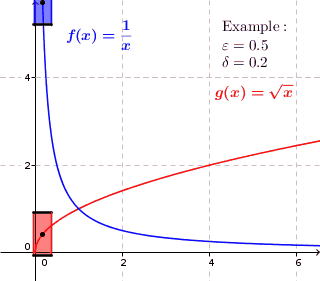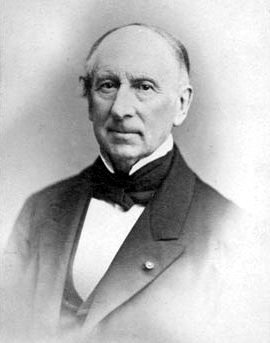|
Microcontinuity
In nonstandard analysis, a discipline within classical mathematics, microcontinuity (or ''S''-continuity) of an internal function ''f'' at a point ''a'' is defined as follows: :for all ''x'' infinitely close to ''a'', the value ''f''(''x'') is infinitely close to ''f''(''a''). Here ''x'' runs through the domain of ''f''. In formulas, this can be expressed as follows: :if x\approx a then f(x)\approx f(a). For a function ''f'' defined on \mathbb, the definition can be expressed in terms of the halo as follows: ''f'' is microcontinuous at c\in\mathbb if and only if f(hal(c))\subseteq hal(f(c)), where the natural extension of ''f'' to the hyperreals is still denoted ''f''. Alternatively, the property of microcontinuity at ''c'' can be expressed by stating that the composition \text\circ f is constant on the halo of ''c'', where "st" is the standard part function. History The modern property of continuity of a function was first defined by Bolzano in 1817. However, Bolzano's wor ... [...More Info...] [...Related Items...] OR: [Wikipedia] [Google] [Baidu] |
Continuous Function
In mathematics, a continuous function is a function such that a small variation of the argument induces a small variation of the value of the function. This implies there are no abrupt changes in value, known as '' discontinuities''. More precisely, a function is continuous if arbitrarily small changes in its value can be assured by restricting to sufficiently small changes of its argument. A discontinuous function is a function that is . Until the 19th century, mathematicians largely relied on intuitive notions of continuity and considered only continuous functions. The epsilon–delta definition of a limit was introduced to formalize the definition of continuity. Continuity is one of the core concepts of calculus and mathematical analysis, where arguments and values of functions are real and complex numbers. The concept has been generalized to functions between metric spaces and between topological spaces. The latter are the most general continuous functions, and their d ... [...More Info...] [...Related Items...] OR: [Wikipedia] [Google] [Baidu] |
Nonstandard Analysis
The history of calculus is fraught with philosophical debates about the meaning and logical validity of fluxions or infinitesimal numbers. The standard way to resolve these debates is to define the operations of calculus using (ε, δ)-definition of limit, limits rather than infinitesimals. Nonstandard analysis instead reformulates the calculus using a logically rigorous notion of infinitesimal numbers. Nonstandard analysis originated in the early 1960s by the mathematician Abraham Robinson. He wrote: ... the idea of infinitely small or ''infinitesimal'' quantities seems to appeal naturally to our intuition. At any rate, the use of infinitesimals was widespread during the formative stages of the Differential and Integral Calculus. As for the objection ... that the distance between two distinct real numbers cannot be infinitely small, Gottfried Wilhelm Leibniz argued that the theory of infinitesimals implies the introduction of ideal numbers which might be infinitely small or inf ... [...More Info...] [...Related Items...] OR: [Wikipedia] [Google] [Baidu] |
Standard Part Function
In nonstandard analysis, the standard part function is a function from the limited (finite) hyperreal numbers to the real numbers. Briefly, the standard part function "rounds off" a finite hyperreal to the nearest real. It associates to every such hyperreal x, the unique real x_0 infinitely close to it, i.e. x-x_0 is infinitesimal. As such, it is a mathematical implementation of the historical concept of adequality introduced by Pierre de Fermat, as well as Leibniz's Transcendental law of homogeneity. The standard part function was first defined by Abraham Robinson who used the notation ^x for the standard part of a hyperreal x (see Robinson 1974). This concept plays a key role in defining the concepts of the calculus, such as continuity, the derivative, and the integral, in nonstandard analysis. The latter theory is a rigorous formalization of calculations with infinitesimals. The standard part of ''x'' is sometimes referred to as its shadow. Definition Nonstandard analysis ... [...More Info...] [...Related Items...] OR: [Wikipedia] [Google] [Baidu] |
Uniformly Continuous
In mathematics, a real function f of real numbers is said to be uniformly continuous if there is a positive real number \delta such that function values over any function domain interval of the size \delta are as close to each other as we want. In other words, for a uniformly continuous real function of real numbers, if we want function value differences to be less than any positive real number \varepsilon, then there is a positive real number \delta such that , f(x) - f(y), 0 there exists a real number \delta > 0 such that for every x,y \in X with d_1(x,y) 0 such that for every x,y \in X , , x - y, 0 \; \forall x \in X \; \forall y \in X : \, d_1(x,y) 0 , \forall x \in X , and \forall y \in X ) are used. * Equivalently, f is uniformly continuous if it admits a modulus of continuity. Definition of (ordinary) continuity * f is called continuous \underline if for every real number \varepsilon > 0 there exists a real number \delta > 0 such that for every y ... [...More Info...] [...Related Items...] OR: [Wikipedia] [Google] [Baidu] |
Uniform Convergence
In the mathematical field of analysis, uniform convergence is a mode of convergence of functions stronger than pointwise convergence. A sequence of functions (f_n) converges uniformly to a limiting function f on a set E as the function domain if, given any arbitrarily small positive number \varepsilon, a number N can be found such that each of the functions f_N, f_,f_,\ldots differs from f by no more than \varepsilon ''at every point'' x ''in'' E. Described in an informal way, if f_n converges to f uniformly, then how quickly the functions f_n approach f is "uniform" throughout E in the following sense: in order to guarantee that f_n(x) differs from f(x) by less than a chosen distance \varepsilon, we only need to make sure that n is larger than or equal to a certain N, which we can find without knowing the value of x\in E in advance. In other words, there exists a number N=N(\varepsilon) that could depend on \varepsilon but is ''independent of x'', such that choosing n\geq N wi ... [...More Info...] [...Related Items...] OR: [Wikipedia] [Google] [Baidu] |
Standard Part Function
In nonstandard analysis, the standard part function is a function from the limited (finite) hyperreal numbers to the real numbers. Briefly, the standard part function "rounds off" a finite hyperreal to the nearest real. It associates to every such hyperreal x, the unique real x_0 infinitely close to it, i.e. x-x_0 is infinitesimal. As such, it is a mathematical implementation of the historical concept of adequality introduced by Pierre de Fermat, as well as Leibniz's Transcendental law of homogeneity. The standard part function was first defined by Abraham Robinson who used the notation ^x for the standard part of a hyperreal x (see Robinson 1974). This concept plays a key role in defining the concepts of the calculus, such as continuity, the derivative, and the integral, in nonstandard analysis. The latter theory is a rigorous formalization of calculations with infinitesimals. The standard part of ''x'' is sometimes referred to as its shadow. Definition Nonstandard analysis ... [...More Info...] [...Related Items...] OR: [Wikipedia] [Google] [Baidu] |
Nonstandard Analysis
The history of calculus is fraught with philosophical debates about the meaning and logical validity of fluxions or infinitesimal numbers. The standard way to resolve these debates is to define the operations of calculus using (ε, δ)-definition of limit, limits rather than infinitesimals. Nonstandard analysis instead reformulates the calculus using a logically rigorous notion of infinitesimal numbers. Nonstandard analysis originated in the early 1960s by the mathematician Abraham Robinson. He wrote: ... the idea of infinitely small or ''infinitesimal'' quantities seems to appeal naturally to our intuition. At any rate, the use of infinitesimals was widespread during the formative stages of the Differential and Integral Calculus. As for the objection ... that the distance between two distinct real numbers cannot be infinitely small, Gottfried Wilhelm Leibniz argued that the theory of infinitesimals implies the introduction of ideal numbers which might be infinitely small or inf ... [...More Info...] [...Related Items...] OR: [Wikipedia] [Google] [Baidu] |
Internal Function
In mathematical logic, in particular in model theory and nonstandard analysis, an internal set is a set that is a member of a model. The concept of internal sets is a tool in formulating the transfer principle, which concerns the logical relation between the properties of the real numbers R, and the properties of a larger field denoted *R called the hyperreal numbers. The field *R includes, in particular, infinitesimal ("infinitely small") numbers, providing a rigorous mathematical justification for their use. Roughly speaking, the idea is to express analysis over R in a suitable language of mathematical logic, and then point out that this language applies equally well to *R. This turns out to be possible because at the set-theoretic level, the propositions in such a language are interpreted to apply only to internal sets rather than to all sets (note that the term "language" is used in a loose sense in the above). Edward Nelson's internal set theory is an axiomatic approach ... [...More Info...] [...Related Items...] OR: [Wikipedia] [Google] [Baidu] |
Halo (mathematics)
In nonstandard analysis, a monad or also a halo is the set of points infinitesimally close to a given point. Given a hyperreal number ''x'' in R∗, the monad of ''x'' is the set :\text(x)=\. If ''x'' is finite (limited), the unique real number in the monad of ''x'' is called the standard part of ''x''. References Nonstandard analysis {{mathanalysis-stub ... [...More Info...] [...Related Items...] OR: [Wikipedia] [Google] [Baidu] |
Hyperreal Number
In mathematics, hyperreal numbers are an extension of the real numbers to include certain classes of infinite and infinitesimal numbers. A hyperreal number x is said to be finite if, and only if, , x, [...More Info...] [...Related Items...] OR: [Wikipedia] [Google] [Baidu] |
Cauchy
Baron Augustin-Louis Cauchy ( , , ; ; 21 August 1789 – 23 May 1857) was a French mathematician, engineer, and physicist. He was one of the first to rigorously state and prove the key theorems of calculus (thereby creating real analysis), pioneered the field complex analysis, and the study of permutation groups in abstract algebra. Cauchy also contributed to a number of topics in mathematical physics, notably continuum mechanics. A profound mathematician, Cauchy had a great influence over his contemporaries and successors; Hans Freudenthal stated: : "More concepts and theorems have been named for Cauchy than for any other mathematician (in elasticity alone there are sixteen concepts and theorems named for Cauchy)." Cauchy was a prolific worker; he wrote approximately eight hundred research articles and five complete textbooks on a variety of topics in the fields of mathematics and mathematical physics. Biography Youth and education Cauchy was the son of Loui ... [...More Info...] [...Related Items...] OR: [Wikipedia] [Google] [Baidu] |

